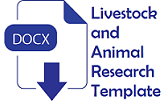Quantitative characteristic of Indonesian native chickens at the age of 4 months
Abstract
Objective: Native chickens (Kampung, Sentul, and Merawang) have great potential to be developed as both meat and egg producers. Quantitative data about native chickens are not widely known. The purpose of this research was to determine the quantitative characteristics of Native Chickens aged 1 month, 2 months, 3 months and 4 months.
Methods: The research material is native chickens. The method used was an 82 sample in each strain and a total of 246 samples. The data collected is of a quantitative traits. Quantitative traits are traits that are influenced by multiple gene pairs, can be measured, and are heavily influenced by environmental factors. Data collected were analyzed using the average difference test (t-test). The average value vector of body measurements of chicken lines was analyzed using the T2-Hotelling statistical test. Main Component Analysis statistical test to identify the shape and size characteristics of each chicken strain. Data processing was assisted by using Minitab statistical software version 18.
Results: The results of this study showed that body weight, weight gain and body size measurements of Kampung chicken were significantly different (P <0.05) higher than Sentul chicken and Merawang chickens. The identifier of the size of the Kampung chicken is the width of the chest, while the identifier of the shape is the length of the back. The identifier of Sentul chicken size is chest length, while the tibia is long. The characteristic of Merawang chicken is the length of the tibia, while the character of the shape is the wing length.
Conclusions: Quantitative characteristics (body weight, weight gain and body size measurements) at the age of 4 months Kampung chickens more heavily than Sentul chicken and Merawang chicken.
Keywords
Full Text:
PDFReferences
- Umam, M.K., H. S. Prayogi, and V. M. A. Nurgiartiningsih. 2014. The performance of Broiler rearing in system stage floor and double floor. J. Ilm-ilm. Pet. 24:79–87. https://jiip.ub.ac.id/index.php/jiip/article/view/207
- Nuraini., Z. Hidayat, and K. Yolanda. 2018. Performa bobot badan akhir, bobot karkas serta persentase karkas ayam Merawang pada keturunan dan jenis kelamin yang berbeda. Si. Pet. 16:69-73. https://jurnal. uns.ac.id/Sains-Peternakan/article/view/23 236
- Sitanggang, E.N., Hasnudi and, Hamdan, 2016. Keragaman sifat kualitatif dan morfometrik antara ayam Kampung, ayam Bangkok, ayam Katai, ayam Birma, ayam Bagon dan Magon di Medan. J. Pet. Intr. 3:167–189. https://talenta.usu.ac.id/jpi/ article/view/2753/2099
- Ashifudin, M., E. Kurnianto, and Sutopo. 2017. Karakteristik morfometrik ayam Kedu jengger merah dan jengger hitam generasi pertama di satker ayam Maron-Temanggung. J. Ilm. Tern. 17:40–46. http://jurnal.unpad.ac.id/jurnalilmuternak/article/view/14825
- Gasperz, V. 2006. Teknik analisis dalam penelitian percobaan. Tarsito, Bandung.
- Awaludin. 2012. Strategi pengembangan ayam Biromaru dalam upaya penyediaan bibit ayam pedaging lokal. Ijas 2: 64–70. doi: https://doi.org/10.24198/ijas.v2i2.2735. g2371.
- Pagala, M.A., L. A. Nafiu, and S. Maharani. 2019. Keragaan ukuran dimensi tubuh hasil persilangan ayam Petelur dan Bangkok pada fase starter. J. Ilm. Tek. Pet. Trop. 6:251–258. doi: http://dx.doi.org/ 10.33772/jitro.v6i2.7140.
- Djego, Y., J. N. Kihe, and H. T. Pangestuti. 2019. Efek komposisi genotip dari ayam ras Petelur, Kate dan lokal Sabu terhadap sifat-sifat pada bobot badan dan ukuran tubuh. J. Nuk. Pet. 6:20–25. doi: https://ejurnal. undana.ac.id/nukleus/article/view/1890.
- Trisiwi, H. F. 2017. Pengaruh level protein pakan pada masa pertumbuhan terhadap penampilan pada awal peneluran ayam betina hasil persilangan ayam Kampung jantan dan ayam ras Petelur betina. J. Ilm. Tek. Has. Tern. 12:61–68. doi:https://doi. org/10.21776/ub.jitek.2017.012.02.1.
- Urfa, S., H. Indijani, and W. Tanwiriah. 2017. Model kurva pertumbuhan ayam Kampung Unggul Balitnak (KUB) umur 0-12 minggu. J. Ilm. Tern. 17:59–66. doi:// https://doi.org/10.24198.jit.v17i1.14863.
- Rajab., B. J. Papilaya. 2012. Sifat kuantitatif ayam Kampung lokal pada pemeliharaan tradisional. Agrinim. 2:61–64. https:// ejournal.unpatti.ac.id/ppr_paperinfo_lnk.php?id=320
- Puteri, N. I., Gushairiyanto, and Depison. 2020. Growth patterns, body weight and morphometric of KUB chicken, Sentul chicken and Arab Chicken. Bul. Pet. 44:67-72. https://doi.org/10.21059/buletin peternak.v44i3.57016
- Alwi, M., C. Sumantri, and S. Darwati. 2014. Karakteristik genetik dan fenotip ayam Nunukan di Pulau Tarakan, Kalimantan Timur. J. Vet. 15:173–181. https://ojs.unud.ac.id/index.php/jvet/article/view/9644
- Hikmawaty,. A. Gunawan., RR. Noor, and Jakaria. 2014. Identifikasi ukuran tubuh dan bentuk tubuh sapi Bali di beberapa pusat pembibitan melalui pendekatan analisis komponen utama. J. Ilm. Prod. Tek. Has. Pet. 2: 231–237. doi: https://journal.ipb.ac.id/index.php/ipthp/article/view/15571
- Magfira., R. I. Arifiantini., N. W. K. Karja, andS. Darwati. 2017. Efektivitas low density lipoprotein dan kuning telur ayam dan puyuh pada pengawetan semen ayam Merawang (effectivess of low density lipoprotein and egg yolk from chicken and quail on Merawang semen preservation). J. Vet. 18:345-352. https://doi.org/10.19087/ jveteriner.2017.18.3.345.
- Pamungkas, F. A., 2005. Beberapa kriteria analisis penduga bobot tetas dan bobot hidup umur 12 minggu dalam seleksi ayam Kampung. JITV. 10:281–285. https:// core.ac.uk/download/pdf/236129371.pdf
- Lukmanudin, M., C. Sumantri, and S. Darwati. 2018. Ukuran tubuh ayam lokal silangan ipb d-1 generasi kelima umur 2 sampai 12 minggu. J. Ilm. Prod. Tek. Has. Pet. 6: 113–120. https://doi.org/10.29244/ jipthp.6.3.113-120.
- Mariandayani, H. N., D. D. Solihin., S. Sulandari., and C. Sumantri. 2013. Keragaman fenotipik dan pendugaan jarak genetik pada ayam lokal dan ayam broiler menggunakan analisis morfologi (phenotypic variation and estimation genetic distance between local chicken and broiler chicken using morphological analysis). J. Vet. 14:475–484. https://ojs. unud.ac.id/index.php/jvet/article/view/7683
- Kurnianto, E., S. Sutopo., E. Purbowati., E.T. Setiatin., D. Samsudewa, and T. Permatasari. 2013. Multivariate analysis of morfphological traits of local goats in Central Java-Indonesia. Iran. J. App. Anim. Sci. 3:361- 367. http://ijas.iaurasht.ac.ir/ article_513999.html
- Permadi, A.N.N., E. Kurnianto, and Sutiyono. 2020. Karakteristik morfometrik ayam Kampung jantan dan betina di Desa Tirtomulyo Kecamatan Plantungan, Kabupaten Kendal, Jawa Tengah. J. Pet. Ind. 22:11–20. https://doi.org/10.25077/jpi. 22.1.11-20.2020
- Putri, A. B. S. R. N., Gushairiyanto, and Depison. 2020. Bobot badan dan karakteristik morfometrik beberapa galur ayam lokal. Jurnal Ilmu dan Teknologi Peternakan Tropis. 7(3): 256-263. DOI: http://dx.doi.org/10.33772/jitro.v7i3.12150.
- Mahmudi., R. Priyanto, and Jakaria. 2019. Karakteristik morfometrik sapi Aceh, sapi PO dan sapi Bali berdasarkan analisis komponen utama (aku). J. Ilm. Prod. Tek. Has. Pet. 7:35–40. https://journal.ipb.ac.id/ index.php/ipthp/article/view/25040.
Refbacks
- There are currently no refbacks.










